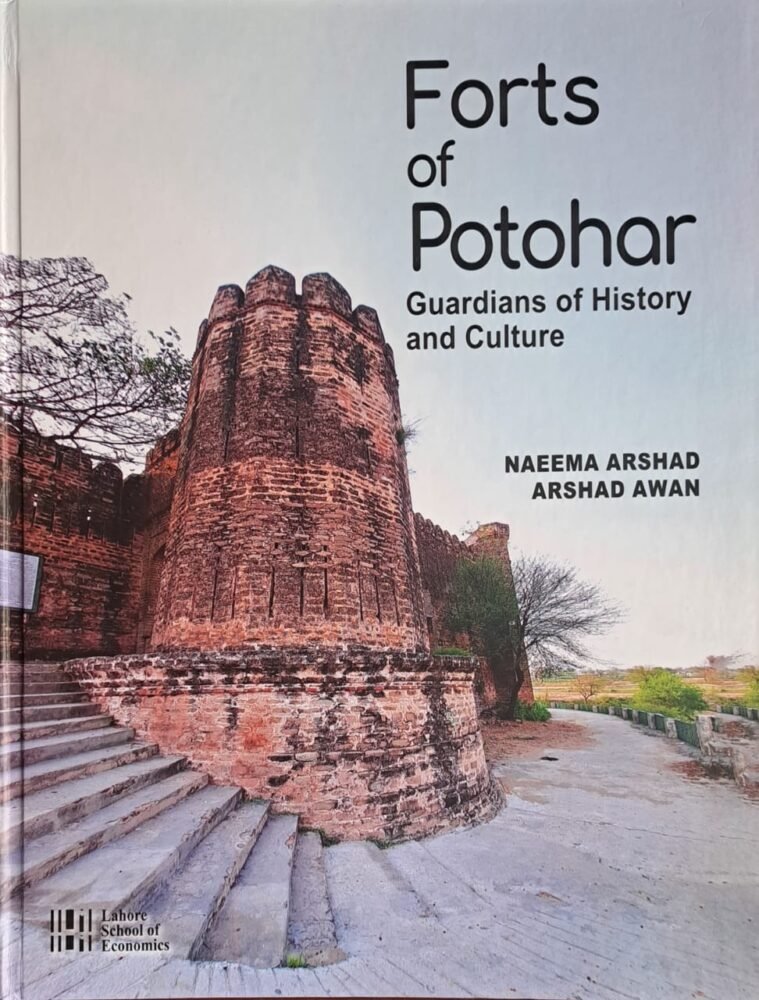by Farman Ali
The Potohar region, with its rugged charm and profound historical depth, has long captivated the imagination of historians, travellers, and archaeologists alike. Its plateaus and timeworn relics whisper stories of forgotten civilizations and vibrant cultural legacies. Countless books and travelogues have explored its lost heritage and dynamic social fabric, including the seminal Potohar: Khita-e-Dilruba (Potohar: The Land of the Beloved) by Professor Dr. Shahid Hassan Siddiqui, which offers a deeply human portrait of Rawalpindi’s literary and social life.
Now, a new chapter is being added to Potohar’s unfolding narrative. Forts of Potohar, authored by Naeema Arshad, assistant professor at the Lahore School of Economics, and co-authored by her husband Arshad Awan, brand strategist, and visiting faculty at the same institution, delivers a compelling, meticulously researched exploration of the region’s architectural legacy. This landmark work breathes life into the silent sentinels of the Potohar Plateau—fortresses that have weathered the tides of Buddhist, Sikh, and Mughal dominion, standing as enduring testaments to the region’s turbulent yet rich past. With clarity and reverence, the authors illuminate the cultural heartbeat of Potohar through its mighty stones and forgotten walls, offering readers a fresh lens on Pakistan’s layered heritage.

Stretching from the Attock to the Jhelum River, Potohar is more than a scenic landscape—it is a cradle of ancient civilizations. Its forts, scattered across hills and valleys, stand as weathered sentinels of conquest, resistance, and survival. In this book, the authors take readers on a visually compelling journey, combining scholarly rigor with evocative storytelling to illuminate the architecture and forgotten histories of these once-mighty structures.
What makes Forts of Potohar stand out is its interdisciplinary approach. Drawing on six years of fieldwork, archival research, oral histories, and archaeological evidence, the book examines twenty forts in individual chapters. Each one is explored not only for its architectural features but also for its socio-political significance—whether as military outposts, administrative centres, or symbols of power.
The narrative brings these forts vividly to life. From the imposing walls of Rohtas Fort to the remote ruins of Pharwala, the authors provide richly detailed descriptions that transport readers to another era. Their ability to recreate the atmosphere and importance of each site marks the book as a masterclass in historical writing.
One of the book’s standout chapters focuses on Rohtas Fort, a 16th-century stronghold built by Sher Shah Suri. The authors dissect its military innovations, such as its formidable walls and intricate gateways, while situating it within the broader context of regional political upheaval. Likewise, their exploration of Pharwala Fort sheds light on the Mughal and Sikh struggles for dominance, enriched by both textual sources and local oral traditions.
Beyond historical narration, the book raises urgent concerns about heritage preservation. Many of these forts are deteriorating due to neglect and encroachment. Arshad and Naeema make a compelling case for conservation, arguing that these sites are not just remnants of the past but integral to Pakistan’s cultural identity.
The book, funded by the Lahore School of Economics, is also a practical guide for travellers, adventurers, and cultural enthusiasts. With maps, photographs, and historical context for each site, it offers a comprehensive and accessible resource for those eager to explore the region.
Despite its academic foundation, Forts of Potohar remains highly readable, engaging and free of jargon, striking a balance between depth and accessibility. High-quality images—of crumbling stone walls, ornate carvings, and sweeping landscapes—add emotional weight to the text and underscore what’s at risk if these monuments are not preserved.
At its heart, the book is a tribute to a region often overlooked in mainstream historical narratives. It bridges past and present, reminding readers that modernization must not come at the expense of heritage. Through their meticulous work, Naeema and Arshad, my former colleague at the Financial Post, Karachi, issue a call to action—for policymakers, educators, and the public—to recognize the value of these historical treasures.
Forts of Potohar is a major contribution to South Asian history and archaeology. For scholars, it offers deep insights; for travellers, a captivating guide; and for all readers, a poignant reminder of the importance of preserving our shared heritage. These forts are more than relics—they are the echoes of empires and the silent storytellers of our past. This book ensures their voices are not lost.

The High Asia Herald is a member of High Asia Media Group — a window to High Asia and Central Asia
